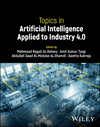A Smarter Way to Collect and Store Data
AI and OCR Solutions for Industry 4.0 Systems
Summary
The collection and storage of data in Information Technology (IT) databases pose significant challenges for the integration of legacy Operational Technology (OT) systems, particularly in the context of social infrastructure. Specialized industrial controllers, with unique display panels, may present difficulties in connecting to modern IT-based data collection networks. To address these issues, a noninvasive wireless solution is proposed that utilizes Optical Character Recognition (OCR) techniques to extract OT data from controllers and connect them to Artificial Intelligence (AI) applications in a secure and accessible manner. This approach involves recording real-time streaming video data using video cameras like the ESP32-CAM module placed in front of the display panels. KerasOCR's detector model detects possible text regions in the frame, and users can create their own Region of Interest (ROI) in case it is not detected. The ROI template created using these methods is applied to all incoming frames to extract text data from selected regions using EasyOCR's recognition model. All changing alphanumeric characters are captured and logged in a CSV file with their time stamps, providing a real-time display of the data and enabling desired event triggers.
This custom-trained solution is designed to be effective even in challenging lighting situations, as it applies to display units with varying designs and text styles. By enabling the collection and integration of data from legacy OT systems into modern IT-based networks, this solution offers a cost-effective approach to bridging the technological gap between legacy infrastructure and modern technologies. KerasOCR's text detection has an F1-score of 83.85%, while EasyOCR's text recognition has a mean Character Error Rate (CER) of 23.3%, which is considerable for the use case. Overall, this research offers a valuable contribution to the field of OT-IT integration and offers practical solutions to the challenges facing legacy infrastructure systems.



